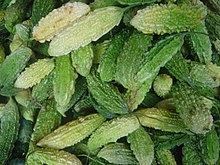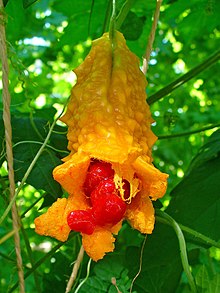Bitter melon
| Bitter melon | ||||||||||||
|---|---|---|---|---|---|---|---|---|---|---|---|---|

Balsam pear ( Momordica charantia ), illustration |
||||||||||||
| Systematics | ||||||||||||
|
||||||||||||
| Scientific name | ||||||||||||
| Momordica charantia | ||||||||||||
| L. |
The bitter melon ( Momordica charantia ), also called bitter cucumber , goya cucumber , balsam pear , balsam apple , or bitter jumping cucumber , is a species of the genus bitter melons ( Momordica ) within the gourd family (Cucurbitaceae). The tropical vegetable fruits of bitter melon have been a popular food and remedy for centuries in many countries, especially in Asia. The growing areas are Africa, Asia, South America and the Caribbean .
Common names in other languages
It is known in Japan and especially Okinawa as Gōyā , in Sanskrit as Karela and in Malayalam as Pavaykka and in Honduras as "Kalaika".
description
Vegetative characteristics
The bitter melon is an herbaceous plant . The prostrate or ascending shoot axes are up to 5 m long and are sparsely to densely hairy, especially at the nodes .
The alternate leaves are divided into a petiole and a leaf blade. The leaf stalk is up to 7 cm long. The leaf blade is at a length up to 10 cm and a width of 12.5 cm wide oval to round in outline, with heart-shaped base. The blade is deeply hand-shaped divided with three to seven lobes. The lobes are each lobed several times or toothed away. The leaf margins are whole and often pointed on the tips of the lobes or teeth. The leaves are sparsely to densely hairy. The thin tendrils are simple and long.
Generative characteristics
The bitter melon is single-sexed ( monoecious ). The five-fold flowers with a double bloom cover stand individually in the leaf axils.
In the male flowers, the bract is up to 17 mm long, broadly oval to kidney-shaped, sessile, with a heart-shaped base, encompassing the stalk, pointed and green. The flower stalk is up to 9.5 cm long. The flower tube is up to 5 mm long, the hairy calyx is short, the calyx lobes 3 to 7 mm long and elliptical. The petals are 1 to 2.5 cm long, light to dark yellow and elliptical to obovate. They have five, three united, fused stamens , with fused anthers.
In the female flowers, the bract is up to 12 mm long and the flower stalk is up to 10 cm long. The flower tube is 1 to 3 mm long, the narrow calyx tips 2 to 5 mm long and lanceolate. The petals are 0.7 to 1.2 cm long. The under constant and unilocular ovary is slightly below the cup (epiperigyn) and is 8 to 11 (rarely 30) mm long and 2 to 4 mm wide, the scars are three-piece-biramose. Staminodes may be present.
The ellipsoidal, leathery berry (Panzer berry, pepo) is 2.5 to 4.8 and (rarely 11) cm long (some cultivars can be significantly longer) 1.5 to 2.3 (rarely 4) cm wide, short beaked with many, partly in rows, partly pointed humps. It is ripe orange and opens with three flaps. The fruit stalk is 3.4 to 15 cm long. The seeds are (8 to 11) × (4.5 to 8) × (2 to 3.5) mm in size and encased in a sticky, red seed coat (false aril ) "pulp", they are elongated to elliptical, flattened, light brown and have a grooved edge. The pulp is edible and tastes sweet.
The number of chromosomes is 2n = 22.


Occurrence
The bitter melon is pantropical , but was probably introduced in America at the time of the slave trade. It grows wild on river and lake banks and on abandoned cultivated areas. It occurs in Africa at altitudes up to 1650 meters. In the Neotropic , it grows mainly on disturbed locations from Brazil to the southeastern United States, where it is a common " weed ".
Cultivation
The bitter melon is grown in the hot and humid tropics at altitudes of up to 500 meters. Fertile soils with good water holding capacity are best suited. The plants are often grown on trellises . The flowering period begins about five weeks after sowing . Depending on the variety, the unripe fruits can be harvested one to three weeks later and weigh 80 to 120 g. The yields can be 8 to 15 tons per hectare. Diseases and pests are rare due to the many toxic ingredients. However, the bitter melon is sensitive to the watermelon virus and other viruses .
The individual varieties and races of bitter melon have been relatively little researched. In China and India in particular, there are a number of varieties that differ in growth form, ripening time and fruit characteristics such as size, shape, color and surface. In India, large-fruited, thick-fleshed hybrid varieties were bred.
use
In tropical countries where the bitter melon thrives, the fruits are offered in markets. A vegetable dish made from unripe fruits is popular in Asian cuisine. Before preparation, after removing the seeds, the pulp is cut into thin slices and rubbed with salt to reduce bitter substances. In India, especially in Bengal, it is considered appetizing and is often served as a starter.
Leaves, fruits, seeds and seed oil are used in traditional medicine. They contain fatty oil, insulin-like peptides , Momordin , Charantin and Momordicin . Unripe fruits are used in type 2 diabetes . Bitter melon is said to be helpful in the case of worms, bladder stones, fever and stomach ulcers.
As a medicinal plant, a Venetian manuscript from 1435 named "momordica id est caranza", although the text from around 1400 could also refer to the related pumpkin plant Momordica balsamina L. (the "Jerusalem apple "). The healing properties of the “craut” momordica are also described in a German-language version from 1460 .
pharmacology
In 2004, the Österreichische Apothekerzeitung published an article which concluded:
- " As numerous patents prove, Momordica charantia is currently being propagated in the field of dietary supplements and supplements in America. In research, various active ingredients u. a. in HIV treatment or for their anti-carcinogenic effects. The blood sugar -lowering effect of M. charantia in type II diabetics is offset on the one hand by the poor clinical data situation and on the other hand by the mostly inadequate standardization and declaration of any products available on the market. In Austria and Germany there are currently no medicinal specialties. As non-medicinal products in Austria z. B. »charantea«, a tea made from dried seeds and fruits for diabetics, available in Germany as a dietary supplement (eg glucokine) or as a dietetic food for diabetics. The additive use of M. charantia must always be carried out under the supervision of the attending physician in addition to drug therapy, nutritional measures and a sensible exercise program in type II diabetics. "
There are still only a few clinical studies that prove the positive effects of bitter melon. The following effects have been scientifically shown in laboratory studies and animal experiments since 2004 :
- it has an anthelmintic effect against worm infestation with Caenorhabditis elegans and with viral diseases with Sindbis and Herpes simplex type I;
- the juice has a protective effect on the gastric mucosa of rats;
- it may be effective against obesity in rats by interfering with lipid metabolism;
- sperm are damaged by anti-androgenic effects in rats ;
- Linolenic acids from the seeds produced cell death in certain cancer cells;
- the plant contains antifungal substances to which the fungi Candida albicans , Trichophyton rubrum and Cryptococcus neoformans are sensitive.
- it lowers blood sugar levels in prediabetics.
Side effects
In the event of an overdose , stomach and abdominal pain or diarrhea may occur. The tea should be prepared in such a way that it is tasty and not too bitter. Especially in the case of diabetes and circulatory disorders, a daily amount of one liter per capsule or serving is recommended. Pregnant women are not advised to use them, as individual ingredients have harmful effects on the fertility.
literature
- C. Jeffrey: Momordica charantia. In: Flora Zambesiaca. Volume 4, 1978, (online) . (Characteristics, distribution)
- RW Robinson, DS Decker-Walters: Cucurbits. CAB International, Wallingford 1997, ISBN 0-85199-133-5 (use, distribution).
Web links
- Momordica charantia . In: U. Brunken, M. Schmidt, S. Dressler, T. Janssen, A. Thiombiano, G. Zizka: West African plants - A Photo Guide. Senckenberg Research Institute, Frankfurt am Main 2008.
- Momordica charantia at Useful Tropical Plants, accessed October 28, 2018.
Individual evidence
- ↑ Morton, Julta F. (1967): The balsam pear - an edible, medicinal and toxic plant . Economic Botany 21 (1): 57-68. doi : 10.1007 / BF02897176
- ↑ Momordica charantia at Tropicos.org. In: IPCN Chromosome Reports . Missouri Botanical Garden, St. Louis
- ↑ Andrew Chevallier: The great lexicon of medicinal plants. Dorling Kindersley, Munich / Starnberg 2001, ISBN 3-8310-0167-7 , p. 235.
- ↑ Josef Domes: Momordica treatise. In: Author's Lexicon . Volume VI, Col. 645 f.
- ^ A b Sonja Prinz, Brigitte Kopp: The hypoglycemic effect of bitter melon in type II diabetes. In: Information from the Österreichische Apothekerzeitung. No. 3, 2004. Online version ( Memento from December 5, 2009 in the Internet Archive )
- ↑ JK Grover, SP Yadav: Pharmacological actions and potential uses of Momordica charantia: a review. In: Journal of Ethnopharmacology , Volume 93, Issue 1, 2004, pp. 123-132, PMID 15182917 .
- ↑ N. Beloin et al .: Ethnomedicinal uses of Momordicacharantia (Cucurbitaceae) in Togo and relation to its phytochemistry and biological activity. In: J Ethnopharmacol. 96 / - / 2005. Pp. 49-55, PMID 15588650 .
- ↑ P. Das et al .: Screening of antihelminthic effects of Indian plant extracts: a preliminary report. In: J Altern Complement Med. 12/3/2006. Pp. 299-301, PMID 16646729 .
- Jump up ↑ GO Dengiz, N. Gursan: Effects of Momordica charantia L. (Cucurbitaceae) on indomethacin-induced ulcer model in rats. In: Turk J Gastroenterol. 16/2/2005. Pp. 85-88. PMID 16252198
- ↑ LL Chan et al .: Reduced adiposity in bitter melon (Momordica charantia) -fed rats is associated with increased lipid oxidative enzyme activities and uncoupling protein expression. In: J. Nutr. 135 (11), 2005, pp. 2517-2523, PMID 16251604 .
- ↑ MM Girini et al .: Effect of graded doses of Momordica charantia seed extract on rat sperm: scanning electron microscope study. In: J. Basic Clin. Physiol. Pharmacol. 16 (1), 2005, pp. 53-66, PMID 16187486 .
- ↑ Y. Yasui et al .: Bitter gourd seed fatty acid rich in 9c, 11t, 13t-conjugated linolenic acid induces apoptosis and up-regulates the GADD45, p53 and PPARgamma in human colon cancer Caco-2 cells. In: Prostaglandins Leukot Essent Fatty Acids. 73 (2), 2005. pp. 113-119, PMID 15961301 .
- ↑ G. Schmourlo et al .: Screening of antifungal agents using ethanol precipitation and bioautography of medicinal and food plants. In: J. Ethnopharmacol. 96 (3), 2005, pp. 563-568, PMID 15619579 .
- ↑ Study proves effectiveness: bitter melon can help against diabetes on t-online.de, February 20, 2018.




